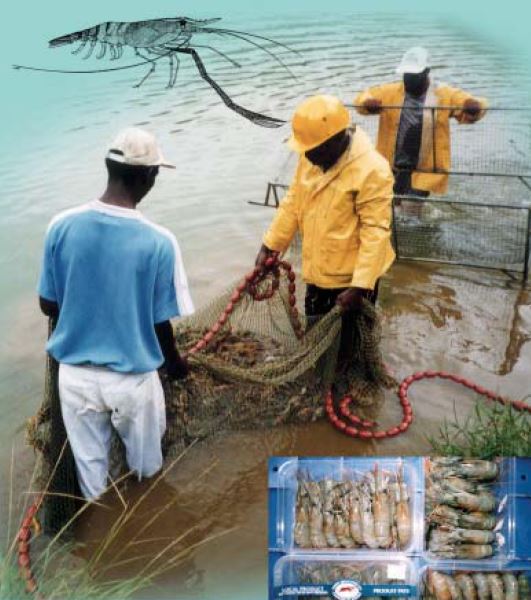Farming freshwater prawns
Farming freshwater prawns
A manual for the culture of the giant river prawn (Macrobrachium rosenbergii)

by Michael B. New Marlow, United Kingdom
FOOD AND AGRICULTURE ORGANIZATION OF THE UNITED NATIONS
Rome, 2002
PREPARATION OF THIS DOCUMENT
A PREVIOUS MANUAL ON THIS TOPIC was prepared for FAO in 1982 and revised in 1985 but the English edition is now out-of-print. Research has generated considerable benefits on this subject and substantial advances in technology have occurred since the original manual was published.
These facts, combined with a revival in interest in expanding the farming of freshwater prawns, have created the need for a new technical manual.
This document has therefore been prepared to provide up-to-date and practical information on freshwater prawn farming. Its emphasis is on techniques for cultivating the major farmed species, namely the giant river prawn (Macrobrachium rosenbergii). The manual also contains information of relevance to the farming of other Macrobrachium species and to the enhancement of freshwater prawn fisheries.
The document was prepared under contract for the Inland Water Resources and Aquaculture
Service, FAO Fishery Resources Division, by one of the authors of the original FAO manual, Michael B. New. It is a synthesis of the personal experience of the author and of his many international friends and colleagues working in this field, who are gratefully acknowledged within the manual text.
The principal targeted audience includes trainers, extension agents, farmers, and students. It is also hoped that the manual will provide background information and reference sources for those embarking on research in this field.
The designations employed and the presentation of material in this information product do not imply the expression of any opinion whatsoever on the part of the Food and Agriculture Organization of the United Nations concerning the legal status of any country, territory, city or area or of its authorities, or concerning the delimitation of its frontiers or boundaries.
abstract
THE ORIGINAL MANUAL on freshwater prawn farming was published in English, French and Spanish by FAO and translated by others into Farsi, Hindi, and Vietnamese. In the two decades since that manual was written, many technical and practical advances have been made in the rearing of freshwater prawns. Greater farmed production, developing global markets, and the need to ensure that each form of aquaculture is sustainable, have led to an increased interest in the farming of freshwater prawns. A new manual has therefore been prepared, which will be issued in each of the FAO official languages.
This manual provides information on the farming of Macrobrachium rosenbergii.
Many of the techniques described are also applicable to other species of freshwater prawns that are being cultured. The manual is not a scientific text but is intended to be a practical guide to in-hatchery and on-farm management. The target audience is therefore principally farmers and extension workers. However, it is also hoped that, like the previous manual on this topic, it will be useful for lecturers and students alike in universities and other institutes that provide training in aquaculture.
After a preliminary section on the biology of freshwater prawns, the manual covers site selection for hatcheries, nurseries and grow-out facilities, and the management of the broodstock, hatchery, nursery and grow-out phases of rearing. Harvesting and post-harvest handling are also covered and there are some notes on marketing freshwater prawns. The reference and bibliography section is generally restricted to a list of relevant reviews, as well as other (mainly FAO) manuals on general aquaculture themes, such as water and soil management, topography, pond construction and simple economics. Every attempt has been made to illustrate the management principles described in this manual by photographs and drawings. The manual contains many annexes on specific topics, such as the production of larval feeds, size variation and stock estimation. The final annex is a glossary; this lists not only terms used in the manual itself but also terms which the readers may find in other documents that they may consult.
Key words: Macrobrachium, broodstock management, crustacean culture, freshwater prawns, hatchery operation, grow-out procedures, post-harvest handling and marketing, site selection